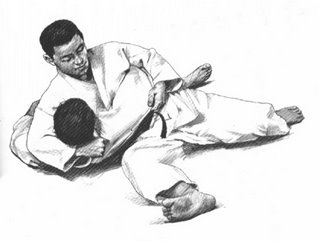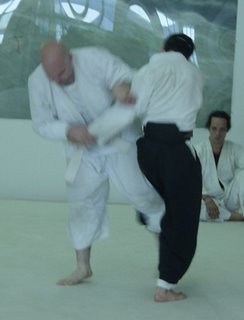Elizabeth, come up. Oh and bring a knife! - Sensei Coleman
Sundays are always full of quotes.
Welcome Tammy!
1. Warmup - Pushups
So i'm doing the push-ups. My back is straight, me head is up. I drop, tuch my obi knot to the ground, I push back up...Ich, Ni, San, Shi, Ju...NiJu...SanJu. I couldn't believe it, I was up to 30! Just 10 more to go! Wrong! I thought if I made it to 40 I would be good, when Sensei kept counting I fell out. Granted I was really really tired, but more so b/c I had lost connection with my goal. I could have done 10 more, but my concentration had broken. This will be important later on.
2. Striking warmup
From traditional position. Slide in and strike.
A few weeks ago Sensei was telling me "Take the technique" and corrected me on how to hold a pad. This week, I imagined that my body was a wall, and that it was me vs. the force of his punch. I only moved a little ;)
3. Kotegaesh from Crosshand
So on this technique I was working with jeannie., and I had always noticed that she tended to use her arm as opposed to her fingers to move the hand around during Kotegaesh. Granted physically I am stronger then Jeannie, but my hand is not as strong as Jeannie's body. When she applied Kotegaesh, my eyes closed in pain and all my mind's eye saw was a big rectangle ( her body I guess ) pressing against my wrist. It was a really powerful lock. I could even feel her pivot. I was floored.
it's ok to track, you can track, you're encouraged to track, actually you have to track - Sensei Coleman
4. Kotegaesh from Uppercut Knife attack
a. Move laterally like Kotegaesh from crosshand. from the inside block the knife with the x-block
b. With the xblock on lock hand and pivot to throw
* Forgive the lack of info on this technique, it's difficult for me to explain. I'm going to start adding some photos for better descriptions soon.
5. Ikkyu from Crosshand
a. as Uke connects with wrist, revolve grabbed wrist to grab uke's hand
( When I studied aikido the sempai who showed me this said "serve the platter" I tink of it every time I do this technique )
b. Slide slightly in the direction of your center pulling uke off balance
c. Adjust center and finish slide ( this creates a zig zag )
d. pin
*Note a while ago, maybe months ago, Sensei Coleman showed me that you can always drive a knee into uke's ribs to move them
6. Ikkyu from Uppercut Knife attack
a. Move laterally like Kotegaesh from crosshand. from the outside block the knife with the x-block
b. With the xblock on lock hand and rotate the arm for lock
7. Hand through the face from straight punch
Would this be considered Irimi-nage?
a. Hitch step entry
b. parry hand, draw it away
c. slide in and strike the face ( heel palm )
Being an Uke
I have been reading "Angry White Pyjamas" and in it the author discusses being an uke. Basically he talks about when you are an uke you are receiving the technique. It always makes me very happy to be used as a uke, even when the strikes are hard, the throws are tough and the locks are sharp, it's interesting to think that I am accepting this and one day I'll have attributes from my sensei.
Working with a beginner ( & being a beginner )
I saw a lot of myself working with Tammy tonight. I remember being very timid, not knowing what to do. Being exausted before we got to sit ups. Being afraid of taking that huge fall ( that wasn't so long ago )
Sensei Coleman stressed that it's important for me to do my technique correctly while insuring her safety. I think this is very important, I always try to be very mindful of not using too much strength etc. I hope I was gentle enough. I am excited to watch her transform.
Staying Connected
A week ago Sensei Coleman made me stay connected to tori even when I was exhausted. I applied this all week and noticed my ukemi improved dramatically. I had a problem knowing when, and when not to roll etc.
Tonight as Sensei Coleman was using me for demonstration I took a hard wristlock and shifted my attention from sensei to my wrist. ( which was fine, just hurt not damaged ) It's hard to describe the difference, it was like having something that you didn't have, then losing it again. I knew something was different i just didn't know how to get it back, so in closing I'm going to stay connected. I like taking good falls and being used as an uke.



